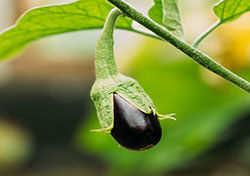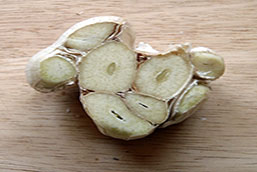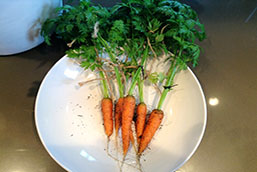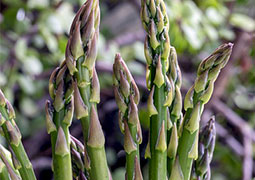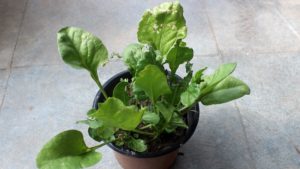Today i will show you how you can grow eggplant at your home in this detailed step-by-step guide.
You’ve probably seen or eaten a pear shaped and deep purple-colored vegetable, but there are more varieties of eggplant that might surprise or interest you. They could come in different sizes, shapes and colors.
It grows wild in India and other Southeast Asia countries. Then, this vegetable reached Europe, particularly Spain, Sicily, and Southern France. It has gained popularity around the world and has finally reached our plates.
Actually, this is my personal favorite among all other vegetables. It has a soft creamy texture and mild taste which blends well with other spices.
It’s actually a vegetarian favorite due to the savory resemblance to meat.
This unique and healthy vegetable could be used for a lot of recipes than parmigiana. For me, frying, baking, grilling and sauteing would still bring out the magnificent taste of eggplant.
That’s why I have them in my garden. I personally grow eggplants on my own backyard for a long lasting supply of eggplants.
Growing it would be a worthwhile investment of your time and effort. But take note that planting an eggplant might take a bit more time and effort than other plants.
I assure you though, the harvest would be really rewarding.
How to Grow Your Own Eggplant
Eggplant in an annual type of plants which makes means it grows in one to two seasons. After harvesting the crop, they eventually die.
But some areas in Southeast Asia, this plant is considered perennial.
It normally needs a hot weather since its origin is normally warm and humid. It usually needs a 3 hours to six hours of direct sunlight.
That’s why I treat this plant as a warm weather plant and makes sure to place the garden bed that has complete sun exposure.
However, they may still thrive in slightly colder weather, but the optimum way to plant this is on warm to hot weather conditions.
Moreover, they also need to be planted in well-drained location.
This plant could actually be the hardest to grow because it needs more preparation and maintenance.
They need consistent nutrients in the soil and watering. And the worst part is: this plant has a lot of natural pests and diseases.
While they need a well draining soil to avoid diseases, they also need to be watered well, or else, it might result to bitter and small crops.
This plant also may take a lot of space when planted. They tend to grow into a tall angular plant, which is why a 24 to 36 inches of space is needed between each plant.
You might be feeling discouraged by now. Don’t be! I’ll be giving you information and tips to grow your eggplants and harvest beautiful and perfect purple veggies.
But it all boils down to one thing: planting an eggplant is all about timing. You have to plant at the right time, apply fertilizer at the right time, and harvest at the right time.
What’s more rewarding than to have a pest-free eggplant for lunch and dinner, right? That’s why get ready because we’re about to start digging.
How Much Time It Take To Grow Eggplants
| Eggplant Type | Growth time |
|---|---|
| Chinese eggplant | 50 to 60 days |
| Fairy Tale Eggplant | 90 days |
| Globe Eggplant | 65 to 80 days |
| Graffiti Eggplant | 65 to 80 days |
| Indian Eggplant | 100 to 120 days |
| Italian Eggplant | 70 days |
| Japanese Eggplant | 50 to 60 days |
| Rosa Bianca Eggplant | 70 to 80 days |
| Thai Eggplant | 120 to 140 days |
| White Eggplant | 65 to 85 days |
| Casper Eggplant | 75 to 80 days |
How To Grow Eggplant
To learn how to grow an eggplant, let’s start off with the basics. On this first part, we will get into the basic requirements to grow and eggplant. Ready your notebook and pen because even if this is just the beginning, the starting point is as important.
Planting Eggplant
Where can I find eggplant seeds?
Visit the nearest nursery or gardening supplies store to get a couple of seeds. You could also buy premium eggplant seeds through here. I personally guarantee that this came from a healthy mature plant that is free from diseases.
Using seeds is more viable than using seedlings. If you want a long-lasting plant, plant with seeds. They grow in an average of four years long.
Eggplant seeds need a warm soil for it to thrive. Specifically, it needs 60 degrees Fahrenheit to 95 degrees Fahrenheit (15 – 35 degrees Celsius) to germinate.
That’s why it is recommended to grow this plant indoors, unless you live in a warm area.
After seven to ten days, seedlings start to emerge. Due to the big leaves of this plant, proper sun exposure could lead to faster seedling growth.
When is the best time to plant eggplant?
Again, eggplants are heat-loving type of vegetable. That’s why timing of planting this for direct exposure to sunlight is very substantial.
Start by planting the seeds four to six weeks before the last frost date. Seedlings are ready to be transplanted after six to eight weeks, which makes the timeline suitable for transplanting.
Since the cool weather condition might weaken the plant and result in death, frost will no longer be visible, and soil will be naturally warm.
You may view the planting calendar here to be more precise on planting.
What is the best container to use when planting rosemary?
Since the plant will be transplanted once the seedling has grown roots, two types of pots will be needed.
Eggplants are suitable for container gardening because this plant needs no competition on the nutrients in the soil.
Use small pots or containers during the first part of the seeding. On the other hand, for transplanting, use big pots with at least 5 gallon capacity.
Make sure to use black colored pots on both plants to ensure that heat is trapped in the soil.
Eggplants have large roots; that’s why they need a large container that could carry this huge plant. In particular, one plant should be grown in a 12 – 14 inches wide pot.
Moreover, choose a glazed pot if you tend to forget to water your plants. So if you have a good memory of watering the plants, use unglazed pot. This is because unglazed pots tend to dry out quickly after watering.
Lastly, make sure that the containers have big unclogged draining holes underneath. Too much moisture in the soil may result to diseases that could hinder growth, or worse, harvest.
How do I plant seeds?
Before planting directly to larger pots, plant the seeds first in smaller containers for germination. Make sure that you choose an area for germination that is 80 degrees Fahrenheit to 90 degrees Fahrenheit (26 to 32 degrees Celsius).
Use good quality potting soil.
Before planting, soak the seeds first into a glass of water overnight. This is to give the seeds a head start. Then, plant them ¼ inch below the soil.
To ensure that the seeds are getting enough warmth in the soil, place the pots on direct sunlight.
But if you’re living in colder areas, place them indoors. You could also use a cloche to ensure warmth on the soil.
The seedlings need enough nutrients in the soil, which is why putting one spoonful of fertilizer to the plant is recommended. Start fertilizing after the second week.
After a few weeks, harden off the seedlings to make it transplant-ready. How? Gradually introduce it to new environment with a change in temperature.
Start of by placing it in partial exposure to sunlight. After a few days, place it in an area with full sun exposure.
After six to eight weeks, a seedling with a height of three inches or more could now be transplanted. Make sure that the weather is conducive for planting eggplants. Otherwise, you may postpone when the weather settles.
How do I prepare the soil for transplanting eggplant?
Just like any other plants, eggplants need a well-draining soil. But in eggplant’s case, a well-draining sandy loam soil is most-conducive for their growth.
I usually mix 2 parts of potting soil and one part of sand.
This will give you soil with a consistency that’s conducive to use for eggplants. While the soil gives the nutrients that the plant needs, the sand keeps the moisture.
Make sure that the potting soil you’re using is premium to avoid any disease.
Then, add a fertilizer to ensure that the plants are getting enough nutrients to grow. You may mix it with natural compost. A 1 to 2 cups of compost will do. Or you could mix a 5-10-10 fertilizer one weeks prior to the transplant.
How do I plant eggplant?
Now, let’s move on to the planting. Ready your tools because this is where the action starts.
First, place a staken to provide support to the plant. Stakes are placed early on to avoid soil and growth disruption.
You could also place a row covers to your plant if you live in colder climates. This will provide the heat that is needed by this heat-loving plant.
Place one seedling per pot. This plant grows tall and angular and they could grow big roots. That’s why one seedling per pot is what I recommend to you.
Make sure that you’ve placed the seedling at the same height as how you’ve got it from the seedling pot. Then, water the plant well. Add a layer of mulch at the top to retain moisture, suppress weeds, keep the temperature of the soil.
Growing Eggplant
Now that you’re plant is all set for harvest, all you need to do is maintain it. This will take more time and effort as this contains, fertilizing, watering, and other maintenance procedure.
How and when do I thin my eggplant plant?
Since we do not planted this directly to the soil, we won’t need to thin the plants. We transplanted the seedlings into the soil, so the plants are well-separated from one another.
However, make sure that you transfer the plant into a bigger pot whenever necessary.
How can I properly water my eggplant plant?
While this plant needs enough warmth on the soil and its plants, watering it is also essential.
Underwatering may result to small and bitter crops. They still need a nice and steady supply of moisture in the soil, but not so much that will make it soggy.
Water should reach up to 6 inches deep; that’s why continuous watering is ideal. But the ideal type of watering is through soaker hose or drip system.
Which fertilizer should I use for my vegetable plant and when do I use it?
Adding more nutrients to the soil could yield better results. I normally use a balanced fertilizer twice during the growing season. Example of balanced fertilizer is 10-10-10 combination.
When applying fertilizer, follow the instructions indicated in the label as the application may vary depending on the type and brand of the fertilizer.
Once the plant started to yield crops, side dress with fertilizer. Use calcium nitrate. Apply again after two to three weeks.
For container-grown plants, look out for excessive salt build-up. This might result to stunted growth among the plants, or worse, stop the growth of the plant.
To prevent this from happening, drench the container in clean water every two weeks to remove the excessive salts.
You may want to explore fish or kelp based organic fertilizers since it releases lesser salts that chemical-based products.
How much sun does my eggplant plant need?
We’ve tackled this many times. This plant is heat loving type. It thrives best when exposed to full sunlight. That’s why full sun exposure is recommended.
Exposing the plant with at least eight hours of sun exposure will result in faster growth and yielding.
So if you don’t have a backyard to place your eggplants, you may place it in windowsills. Just choose a window sill that will receive enough sunlight.
Full sun exposure is ideal for eggplants. As well as warm soil to ensure that the plant is thriving.
Which climate better suits eggplant? (Best Hardiness Zones)
You probably know the answer to this question. Yep, you’re absolutely right!
This plant is most ideal to be planted in hot to warm weather conditions. Their tropical heritage makes them more viable in Hardiness Zone 10 & 11. These locations have the longest growing season with shorter winter and long summer.
But for plant growers who treat eggplants as annuals, you could definitely plant them in Hardiness 4 up to 10.
While this plant is conducive for warmer weather, they could still thrive in other weather conditions due to different farming techniques and technology.
For instance, we place the plant in a container so that we could transfer it from one area to another. During winter, we could just transfer the plant indoors. There are other technologies we could use like a heat mat, a plastic mulch and others to ensure warmth in the soil.
How long does it take to grow eggplant and what should I expect in each growing stage?
The following are the growth stages of eggplants:
- Seedlings
After planting the seeds, it would take six to nine weeks for a seedling to grow. When they reach about four inches and above, they could now be transplanted. - Adult Plants
For about 70 to 120 days, this plant is considered a mature plant, but this actually depends on the variety. Adult plants have a complete set of parts: a main stem, several branches, and a lot of leaves. This plant could grow 2 to four feet, which is again depending on the variety.
- Flowers
Purple star-shaped flowers suddenly appears upon reaching maturity. These flowers do not normally need pollinators, as the wind is its natural pollinator. - Fruit
After 50 to 80 days, your plant will then produce crops. A mature eggplant grows from seven to ten inches when mature. Harvest mature plant; you could tell by looking at glossy skin and firm texture crops.
What are the common diseases and pests of eggplant and how do I avoid It?
This plant has a lot of pests and diseases that might hinder your first harvest. Make sure to look for early signs or perform preventive measures. Here are some of the most common pests and diseases and how you could manage it:
- Flea Beetles
This is the most common and the worst pest of an eggplant. They chew on the leaves and the crop which leaves black holes. To avoid this damage, put the immature plant indoors or use a cover for outdoors.
Mature plants could withstand the damage of this pest. Just place them inside or in a cover to ensure that they are free from this pest. - Tomato Hornworms
Tomato Hornworms are 4-inch green caterpillars with white stripe that leave holes to the crop. They also leave white cocoons underneath the leaves. Do not destroy these as these contain parasitic offspring that might scatter to your plant.
You may handpick the caterpillar and spray water to the cocoons using highly pressurized water. - Verticillium wilt
On the category of eggplant diseases, this is the most common. This type of disease attacks the vascular tissue which results to disruption of the movement of nutrients and water.
As a result, the plant experiences stunted growth and fails to produce crops. This will eventually lead to death. To prevent this from happening again, you should rotate your crops. - Powdery mildew
Lastly, powdery mildew is caused by fungi. Symptoms could be seen on leaves. They leave a white powdery substance on a yellowish spot on the leaves. Infection to plant could start from yellowing of leaves and in time result to death.
You may prevent this from happening by using a crop that is resistant to the disease. You should also ensure that the plant is receiving enough sunlight and watering is done on the soil level, not on leaves.
If you wish to go a different direction and use a chemical pesticides, make sure to read the labels of the product. Many of these chemicals are not safe for human consumption so be sure to check the labels, or better yet consult an expert.
What other crops could I plant together with my eggplant?
To save up space or to gain mutually beneficial results, you may be thinking of planting another crop beside your eggplant. Of course, you could, but make sure that planting them side by side would be beneficial.
Eggplants need ample amount of nutrients to thrive, more specifically nitrogen. That’s why planting legumes beside Eggplant could yield better result to your plant.
Bush Beans is another plant that you could grow beside eggplant. This type of herb is a natural insect repellent. It could even repel one of the most notorious pests of eggplants, the Colorado Potato Beetle.
French Tarragon also repels bugs and insects.
What are the crops that will not go well with eggplant?
Luckily, eggplants are not too picky in companions. They could be planted near other plants except fennel. Actually fennel should not be planted near many other plants.
Harvesting Eggplant
Now that we’ve tackled almost everything you need to know about preparation and maintenance, let’s move on to harvesting. Are you excited? So am I. Ready your tools and let’s get back to digging.
When is the best time to harvest eggplant?
This plant takes 120 days to produce mature crops, but be wary on the timing of harvest. Make sure that you are not harvesting under ripe or overripe crops, as these are bitter tasting.
You should look out for fresh and prime crops.
How? Crop should be shiny, glossy and thin. Learning when is the prime time to harvest may require you to cut the crop. The flesh must be cream colored and the seeds should not yet easily visible.
How do I harvest eggplant?
Once you’ve learned how to determine if the plant is ready for harvest, you may now start with the harvest.
I usually wear gloves and long sleeves to prevent the sap and prickles from irritating my skin.
Then, hold the crops gently as it might bruise easily. Use pruners or a sharp knife when harvesting. You may harvest by leaving a short stem just above the crop.
It may take several days to a few weeks to fully harvest your plant.
What is the best way to store the eggplant that I have harvested?
Before storing, carefully rinse the crops with cold and clean water. Pat dry and store in your refrigerator.
This could stay fresh up to seven days.
Featured Table
| Botanical Name | Solanum melongena |
| Plant Type | Vegetable |
| Sun Exposure | Full Sun |
| Soil Type | Sandy |
| Soil pH | Slightly Acidic to Neutral |
| Bloom Time | Summer |
| Flower Color | Purple & White |
| Hardiness Zones | 4, 5, 6, 7, 8, 9, 10 |

